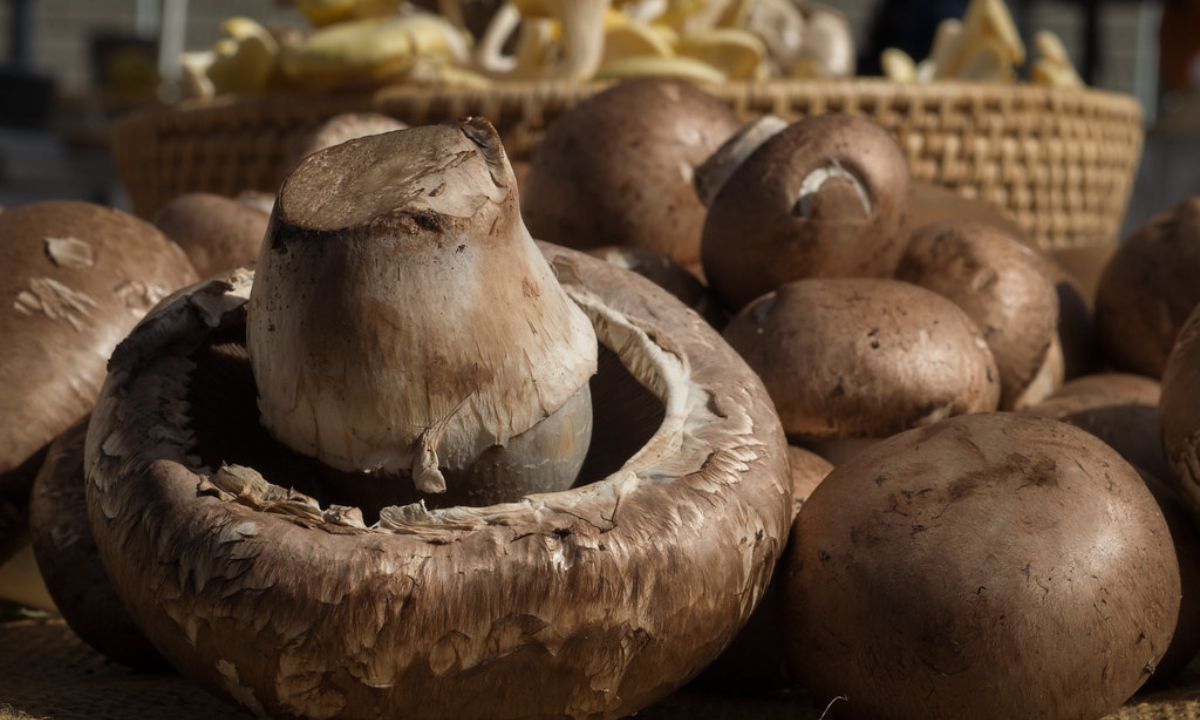How to Grow Portobello Mushrooms at Home 2023
These large, meaty mushrooms are packed with nutrients and make a great addition to any meal.
In this article, we’ll guide you through the steps of growing your own Portobello mushrooms at home, from selecting the right growing medium to harvesting your delicious bounty.
Get ready to discover the joys of homegrown Portobello mushrooms!
Contents
- 1 What You Need to Grow Portobello Mushrooms
- 2 How to Grow Portobello Mushrooms Indoors
- 3 How to Grow Portobello Mushrooms Outdoors
- 4 Things to Avoid When Growing Portobello Mushrooms
- 5 How Long Does it Take to Grow Portobello Mushrooms?
- 6 How to Harvest Portobello Mushrooms
- 7 How to Clean Portobello Mushrooms
- 8 FAQs
What You Need to Grow Portobello Mushrooms
If you’re a beginner, the easiest way to grow portobello mushrooms is to purchase a growing kit. These kits come with everything you need to get started, including the spores, substrate, and instructions.
To grow Portobello mushrooms at home, you’ll need a few key materials:
- Mushroom spawn – This is the “seed” that you’ll use to grow your mushrooms. You can purchase pre-made spawn online or at a gardening store.
- Growing medium – Portobello mushrooms thrive in nutrient-rich compost, so the ideal substrate to use is straw mixed with horse manure. You can purchase pre-made mushroom growing kits or make your own mixture at home.
- Container – You’ll need a container to hold your growing medium. A plastic or metal tray works well, or you can use a large, sturdy plastic bag.
- Moisture source – You can mist them with a spray bottle or set up a humidifier near your growing area.
- Temperature control – Portobello mushrooms grow best at temperatures between 60-70°F (15-21°C). You may need to use a space heater or air conditioner to maintain a consistent temperature.
- Dark, cool environment – Once your mushrooms start to grow, they’ll need a dark, cool environment to mature. You can store them in a cardboard box or paper bag in a cool room or refrigerator.
Regardless of whether youre growing indoors or outdoors, youll need to make sure the soil is damp and at the appropriate temperature.
How to Grow Portobello Mushrooms Indoors
Step 1 – Take your growing container
Choose a large, flat container or tray to place your growing medium in. Make sure it has weep holes.
The drainage holes in the container for growing Portobello mushrooms should be located at the bottom. This allows excess water to drain out of the growing medium and prevent waterlogging.
Small holes about 1/4 inch (0.6 cm) in diameter are enough to provide adequate drainage and prevent the growing medium from spilling out.
Step 2 – Prepare your growing medium
At this point you can use the mix I recommend in the list of materials or prepare your own.
In case you buy the mixture, remember to sterilize the substrate safely to prevent contamination.
Mix composted manure, straw, and other organic materials together to create a nutrient-rich growing medium. Moisten the mixture with water until it is damp but not soggy.
Step 3 – Add Mushroom Seed
Sprinkle the mushroom seed over the surface of the growing medium. Use a fork or spoon to mix the seed into the top 1–2 inches of the growing medium.
Step 4 – Cover with soil
Add a layer of sterile potting soil or vermiculite over the top of the growing medium to help retain moisture.
Step 5 – Place the container and maintain the temperature & humidity
Keep your growing container in a cool, dark place with temperatures between 60 and 70°F (15 and 21°C).
The humidity level needed to grow Portobello mushrooms at home is around 70-80%. As I have mentioned in other posts, I recommend the use of a hygometer to get the humidity level right.
You may need to use a space heater or air conditioner to maintain a constant temperature.
Step 6 – Keep Moist
Mist your growing container with a spray bottle every day to keep the growing medium moist.
You can also cover the container with a damp cloth to help retain moisture.
Step 7 – Watch for growth
After a few days you should start to see little mushroom caps forming. Continue misting the growing medium and maintaining temperature and humidity levels.
Step 8 – Harvest your mushrooms
Once your mushrooms have grown to their full size (about 3–4 inches in diameter), gently turn them over and remove them from the growing medium. Be sure to harvest them before they start releasing spores.
You can continue harvesting mushrooms from your growing container for several weeks. Once mushroom production slows down, you can start the process over again with fresh growing medium and a new mushroom.
How to Grow Portobello Mushrooms Outdoors
This article is focused on growing portobello mushrooms at home, which is what I recommend since you can have more control over the growing conditions.
But, if you’re growing portobello mushrooms outdoors, it’s the same steps as above, but you’ll need to make sure the temperature is between 50-60°F.
This difference in temperature requirements is because indoor environments are generally more stable and consistent in temperature than outdoor environments.
When growing mushrooms outdoors, you have to contend with factors such as changes in temperature, humidity, and weather conditions, which can all affect the growth and development of the mushrooms.
It’s important to note that while outdoor temperatures may be lower than indoor temperatures, outdoor conditions can also provide natural ventilation and air circulation, which can be beneficial for the mushrooms.
Indoor growers need to ensure adequate ventilation to prevent mold growth and ensure healthy air circulation.
You will also need to provide plenty of light, as mushrooms need light to grow. You can use the sun to provide the necessary light.
Things to Avoid When Growing Portobello Mushrooms
These are generally the same mistakes for any other type of mushroom, but it’s important to remember that by avoiding these common mistakes, you can increase your chances of growing healthy portobello mushrooms.
Contamination – Portobello mushrooms are vulnerable to contamination by bacteria, mold, and other fungi. To avoid contamination, be sure to keep your growing area clean and use sterile materials.
Overcrowding – Portobello mushrooms need room to grow, so don’t overcrowd them.
If they are too close together, they may not get enough nutrients or air circulation, which can cause them to become misshapen or stunted.
Inconsistent temperature – Avoid extreme temperature fluctuations, as this can stress the mushrooms and reduce their performance.
Lack of Moisture – Portobello mushrooms require a high level of humidity to grow properly. Keep the growing area moist, but not too moist, to prevent drying out or mold growth.
Poor ventilation – Portobello mushrooms need fresh air to grow, so make sure there is adequate ventilation in the growing area. Stagnant air can cause mold growth and reduce yields.
Inadequate Light – While portobello mushrooms do not require direct sunlight, they do need some light to grow properly. Make sure the growing area has plenty of ambient light, or provide artificial light if necessary.
How Long Does it Take to Grow Portobello Mushrooms?
It typically takes between two to four weeks for portobello mushrooms to grow. The exact time frame will depend on the temperature and humidity of the environment.
How to Harvest Portobello Mushrooms
When the mushrooms are fully grown, you can harvest them. Gently twist the mushrooms off the substrate and brush off any dirt.
How to Clean Portobello Mushrooms
Once youve harvested the mushrooms, youll need to clean them. The best way to clean portobello mushrooms is to rinse them in cold water. You can also use a damp cloth to wipe off any dirt.
FAQs
Q: How to Grow Portobello Mushrooms Without a Kit?
A: If you dont have a kit, you can still grow portobello mushrooms. Youll need to assemble a planting bed and plant portobello spores in it. Make sure to keep the soil damp and at the appropriate temperature.
Q: How to Grow Portobello Mushrooms in Coffee Grounds?
A: You can grow portobello mushrooms in coffee grounds. Start by soaking the coffee grounds in water overnight. Once the grounds are soaked, you can add the portobello spores and keep the substrate damp.
Q: How to Grow Portobello Mushrooms from Spores?
A: To grow portobello mushrooms from spores, youll need to place the spores in a shallow dish and cover with a damp cloth. Place the dish in a warm, dark area and mist the spores with water every day. In a few days, you should see the spores start to germinate. Once the spores have germinated, you can transfer them to the substrate.

